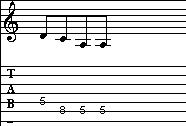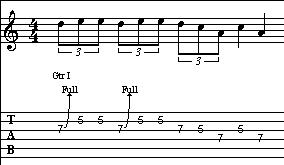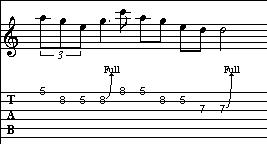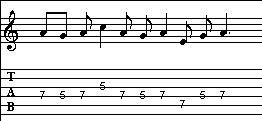Manic GuitarIntroductory Blues Guitar Lesson: The Basics of Blues Guitar | Manic Guitar
Introductory Blues Guitar Lesson: The Basics of Blues Guitar
This lesson is designed to give a basic introduction to blues guitar. I am assuming you have a beginner level of experience on guitar, including a few chords, an ability to read tab and you are comfortable playing some single note material. The lesson is broken down into the basics of blues rhythm guitar and blues lead guitar.
Blues Rhythm
Blues rhythms parts are often based on a group of chord progressions known as the 12 bar blues progression. The simplest form of the 12 bar blues in A is:
| A | A | A | A | D | D | A | A | E | E | A | A |
There are many variations on this progression. Another is as follows:
| A | A | A | A | D | D | A | A | E | D | A | E |
Many blues progressions add either 7th or 9th to the chords. If we add a 7th to the chords in the above progression we get:
These progressions are typically repeated a number of times with either vocals or different musicians soloing over the progression. It is useful to learn to understand progressions by representing the chords as their number in the chosen key. With this notation, the blues progression is as follows:
The number here refers to the note of the scale that the respective chord is based on. For example, as this is a blues in A, these numbers relate to the note of the A major scale that is the root of the chord. So the A chord is the first note of the A major scale, and is represented by I. D is the 4th note and is represented as IV, and E is the fifth note and is represented as V. By understanding this notation, you will eventually be able to change keys with your chord progressions quite easily.
A common way of playing a blues progression is as a shuffle. This tab shows one of the simplest blues shuffles:



If this material is new to you, it would be good to learn the above blues progressions and shuffle. As the chord progressions become natural, try different strumming patterns, and try them in different keys. Also experiment with swing rhythms on the progressions and the shuffle. This involves playing the second note of each beat after the half way point between the two beats.
Blues Lead Guitar
In blues lead guitar, we ultimately want to be able to improvise blues solos. Improvisation involves coming up with a solo that sounds good in a somewhat spontaneous way. If you’re just starting out, that may sound difficult, but there are a few tips to help this process. Mainly, it is important to learn scales. Once you know the right scale, a lot of your improvisation will be using the notes of the scale to come up with nice phrases (or licks). A lot of blues improvisation is based on the blues scale. Here is the tab for the blues scale in A:

This scale needs to become like second nature so you should practice it every day. In order to help ingrain the scale, it is useful to practice sequences of the scale. A sequence involves playing the notes of the scale in a pattern. There are a lot of possible sequences you can practice, so we will go through one of the main sequences. To form a sequence, consider the notes of the scale to be numbered: 1, 2, 3, 4… The sequence of the blues scale we will look at is of the form 1, 2, 3, 2, 3, 4, 3, 4, 5, 4, 5, 6, …. That is 3 notes up and 1 down on the scale all the way up and then down. There is no better way to communicate this than to show the tab, so here it is:



By practicing both the scale and the sequence until they feel natural, you will be that much closer to using the notes of the scale to form blues phrases. A good way to start at this process is to learn a few existing licks, so here is the tab for a few. These licks use the bending of strings, which is very common in blues lead guitar. If you have not learnt this yet, try forming your own versions by sliding between notes.
Blues lick 1:

Blues lick 2:

Blues lick 3:

Once you have learnt a few licks, it is a good idea to practice lead over a backing track. You may want to record yourself playing the above blues shuffle a couple of times and then practice your lead over that. If you’re lucky enough to have a boss loop station, this process will be very simple, but it is well worth while finding a way to practice this over a backing of some sort. Try mixing up the licks you have learnt over your backing track. Then try to take one step closer to improvisation, vary the timing of the licks you have learnt to make them sound a bit different. Then try making up some of your own licks to use in your soloing. Pretty soon you will be using the notes of the scale in a wide variety of ways to form your own solos, and you will be well on the way to improvisation.
Hope this has helped.